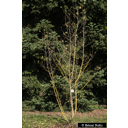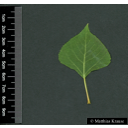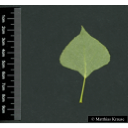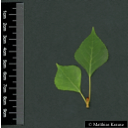Useful information about the taxon (species, subspecies, variety...)
Populus nigra L. 1753
Salicaceae
(APG IV)black poplar
Taxon concept: The Plant List (2010)
Distribution: Europe without Scandinavia; Turkey, the Caucasus, west and east Siberia, middle Asia: Himalaya; northwest Africa; naturalised in Belgium, Denmark
Populus nigra L. - Accepted: Populus nigra L. bei The Plant List (2010); Familie: Salicaceae (APG III)Populus nigra L. - Accepted: Populus nigra L. bei Zander 2008; Familie: Salicaceae (Zander 2008)Populus nigra L. - Accepted: Populus nigra L. bei The Plant List (2014), version 1.1; Familie: Salicaceae (APG III)Populus nigra L. - Accepted: Populus nigra L. bei The Plant List (2014), version 1.1; Familie: Salicaceae (APG IV)Populus nigra L. - Accepted: Populus nigra L. bei BfN Checklist Flora DE; Familie: Salicaceae (APG IV)Populus nigra L. - Accepted: Populus nigra L. bei World Flora Online - APG IV (Angiosperms); Familie: Salicaceae (World Flora Online - APG IV (Angiosperms))
- Flowers
- dioecious species with flowers in catkins
- Flower ecology
- wind-pollinated (anemophilous)
- Life form
- woody, tree
- Foliage persistence
- deciduous
- Fruits
- capsule fruit
- Fruit ecology
- wind-dispersed (anemochorous) and water-dispersed (hydrochorous)
- Root type
- shallow root system
- Succession type
- pioneer species; soil stabilizer
- Natural occurrence (habitat)
- floodplains in mixed forests, oxbow lake
- Vegetation typ and synecology (plant community)
- temperate, mixed mesophytic deciduous forests
- Bark
- dark brown or black bark
Breunig, T. et al. (2021): Rote Liste der Farn- und Blütenpflanzen Baden-Württembergs.; Erhardt, W., Götz, E., Bödeker, N. & Seybold, S. (2008): Der große Zander. Enzyklopädie der Pflanzennamen. Band 2. Arten und Sorten. Eugen Ulmer KG, Stuttgart (Hohenheim), 18. Aufl., 2103 S.; Haider, M. et al. (2005): Wildbienenkataster. See: https://www.wildbienen-kataster.de; Metzing, D. et al. (2018): Rote Liste und Gesamtartenliste der Farn- und Blütenpflanzen (Trachaeophyta) Deutschlands .; The International Plant Names Index (2009). Published on the Internet http://www.ipni.org; Courtesy to IPNI, 2009. Exported from IPNI at date: 2009-09-22 20:17:51; Westrich, P. et al. (2018): Die Wildbienen Deutschlands.. Ulmer Verlag ISBN 978-8186-0123-2.;
Diese Webseite verwendet Google Maps, um Karten und Standorte von Pflanzen in den Hohenheimer Gärten anzuzeigen. Dadurch werden unter Umständen Daten an Google weitergeleitet, was mit einer Verarbeitung Ihrer personenbezogenen Daten verbunden sein kann. Die Datenschutzerklärung von Google finden Sie hier: Datenschutzerklärung von Google
| Sex | Standort | Accession number | Planting year | Donation | IPEN | Lat. | Long. |
|---|---|---|---|---|---|---|---|
| Parzelle Z | LG-Z-105-15313 | 2013 | DE-0-HOH-LG-Z-105-15313 | 48,7047942439 | 9,2130144041 | ||
| Parzelle Z | LG-Z-201-16936 | 2012 | XX-0-HOH-LG-Z-201-16936 | 48,7046981683 | 9,2129705633 | ||
| Parzelle L | SP-LB-007-15311 | 2017 | + | DE-0-HOH-SP-LB-007-15311 | 48,7105852025 | 9,214867308 | |
| Vegetationsgeschichte | VG-15314 | 2013 | DE-0-HOH-VG-15314 | 0 | 0 |





